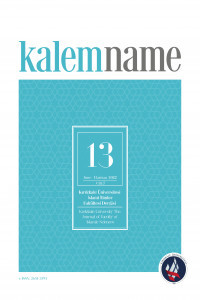Ashâb-ı Kehf Kıssası Bağlamında İsmâil Hakkı Bursevî’de Allah-İnsan İlişkisi
Bu çalışma Ashâb-ı Kehf kıssası bağlamında İsmâil Hakkı Bursevî’ye göre (1063/1653-1137/1725) Allah ile insanın arasındaki ilişki hakkındadır. Bu çalışmada Allah ile insanın arasındaki ilişkinin manevî boyutu analiz edilmiştir. Bursevî’nin yorumuna göre bu ilişkinin dört husûsunun olduğu tespit edilmiştir. Bu çalışmanın tasnîfi de bu hususlara göre yapılmıştır. Ashâb-ı Kehf kıssasının önemi ve anlamı açıklandıktan sonra bu hususlar ele alınmıştır. İlk husus, Allâh’ın mutlak egemenliği karşısında insanın fakrı hakkındadır. İkinci husus, insanın Allâh’a teslîmiyetinin karşılığında onun mârifetullaha ve tecelliyâta ulaşması hakkındadır. Üçüncü husus, insanın Allâh’a duâ etmesi ve Allâh’ın bu duâya icâbet etmesi hakkındadır. Dördüncü husus, ilâhî nusret sâyesinde insanın şecâatli olması hakkındadır. Bu hususlar, Bursevî’nin yorumuna göre analiz edilip ortaya konulmuştur. Ashâb-ı Kehf kıssası bağlamında Allah ile insanın arasındaki ilişkinin özü tevhiddir.
Anahtar Kelimeler:
Tasavvuf, İsmâil Hakkı Bursevî, Ashâb-ı Kehf, Allah-İnsan İlişkisi, Tevhid
The Relationship Between God and Man in the Context of the Legend of the Seven Sleepers According to Ismāʿīl Ḥaḳḳī Bursawī
This research is about the relationship between God and man in the context of the legend of the Seven Sleepers according to Ismāʿīl Ḥaḳḳī Bursawī (1063/1653-1137/1725). The mystical dimension of the relationship between God and man was analyzed. According to Bursawī, who interpreted this legend, the relationship between God and man contains four aspects. The structure of this paper equates to these aspects. Firstly the relevance and importance of the Seven Sleepers was presented. This is followed by the first aspect which is about the almightyness of God over the powerlessness of man. The second aspect is about the surrender of man and the proclamation of God. The third aspect is about the prayer of man and the answer of God. The fourth aspect is about the aid of God which is an encouration for man. All these aspects were analyzed and presented according to the interpretation of Bursawī. The chief motife of the relationship between God and man in the context of the legend of the Seven Sleepers is the belief in the oneness of God (tawḥīd).
Keywords:
Sufism, Ismāʿīl Ḥaḳḳī Bursawī, Seven Sleepers, God-Man Relationship, Tawḥīd,
___
- Aminrazavi, Mehdi. „God, Creation and the Image of the Human Person in Islam”. The Concept of God, the Origin of the World, and the Image of the Human in the World Religions. Editiert von Peter Koslowski. 1/95-111. Dordrecht: Kluwer Academic Publishers, 2001.
- Anḳarawī, Ismāʿīl Rusūḫī. Minhāǧ al-Fuḳarā. Bearbeitet von Safi Arpaguş. Istanbul: Vefa Verlag, 2008.
- Apaydın, H. Yunus. „İbn Kayyim el-Cevziyye“. TDV İslam Ansiklopedisi. 20/109-110. Istanbul: TDV Verlag, 1999.
- Bursawī, Ismāʿīl Ḥaḳḳī. Tefsīr Rūh al-Bayān. Istanbul: Sarmaşık Verlag, 1331.
- __________________. Rūh al-Masnawî. Bearbeitet von İsmail Güleç. Istanbul: Insan Verlag, 2017.
- __________________. Farāḥ al-Rūḥ. Bursa: Uludağ Verlag, 2009.
- Chittick, W.C. „Ṣadr al-Dīn al-Ḳūnawī“. The Encyclopaedia of Islam (New Edition). Editiert von C. H. Bosworth und Weiteren. 8/753-755. Leiden: Brill, 1995.
- Corpus Coranicum. Stand 10.11.2021. https://corpuscoranicum.de/
- Crossen, Craig-Procházka, Stephan. „The Seven Sleepers and Ancient Constellation Traditions-a Crossover of Arabic Dialectology with the History of Astronomy“. Wiener Zeitschrift für die Kunde des Morgenlandes 97 (2007), 79-105. http://www.jstor.org/stable/23861409
- Dağhan, Mehmet Diyadin. Ashâb-ı Kehf Kıssası ve Metafizik Boyutu. Urfa: Harran Universität, Institut für Sozialwissenschaften, Masterthesis, 1998.
- Ǧawziyya, Ibn Ḳayyim al-. al-Fawāʾid. Übersetzt von Bayan Translation Services. Al-Mansūra: Umm Al-Qura, 2004.
- _____________________. Kitāb al-miftāḥ dār al-saʿāda. Beirut: Dār al-kutub al-ʿilmiyya, ohne Erscheinungsjahr.
- Kur’ân Yolu. Stand: 10. November 2021. https://kuran.diyanet.gov.tr/
- Namlı, Ali. „Tasavvuf Kültüründe ve Tasavvufî/İşârî Tefsirlerde Ashâb-ı Kehf Kıssası“. Ekev Akademi Dergisi 55 (Frühjahr 2013), 21-36. http://www.ekevakademi.org/Makaleler/1305443625_2.pdf
- _________. „İsmâil Hakkı Bursevî”. TDV İslam Ansiklopedisi. 23/102-106. Istanbul: TDV Verlag, 2001.
- Nünlist, Tobias. „Sufismus und Futuwwa Männerbünde und ihre sozialen und religiösen Bezüge“. Schutz und Andacht im Islam: Dokumente in Rollenform aus dem 14.-19. Jh. Editiert von Tobias Nünlist. 65-141. Leiden: Brill, 2020.
- Öngören, Reşat. „Mevlânâ Celâleddîn-i Rûmî“. TDV İslam Ansiklopedisi. 29/441-448. Istanbul: TDV Verlag, 2004.
- Ritter, Thomas. „Berichte-Paläoseti in Mythen und Kulten-Die Siebenschläfer-Legende“. Mysteria 300-Magazin für alternative und interdisziplinäre Archeologie 1 (Frühjahr 2003), 67-68. https://mysteria3000.de/magazin/die-siebenschlafer-legende/
- Rūmī, Mawlānā Ǧalāl al-Dīn. Das Maṯnawī. Übersetzt von Bernhard Meyer und Weitere. Konya: Verlag der Stadtverwaltung, 2005.
- Schimmel, Annemarie. Sufismus-Eine Einführung in die islamische Mystik. München: C. H. Beck Verlag, 2008.
- Seligmann, Sigfried. „Das Siebenschläfer-Amulett“. Der Islam-Zeitschrift für Geschichte und Kultur des islamischen Orients 4/5 (1914), 370-388.
- Vırıt, Halil. Sûfîlerin Gözünde Ashâb-ı Kehf. Izmir: Dokuz Eylül Universität, Institut für Sozialwissenschaften, Masterthesis, 2017.
- Yetik, Erhan. „Ismâil Rusûhî Ankaravî“. TDV İslam Ansiklopedisi. 3/211-213. Istanbul: TDV Verlag, 1991.
- Yayın Aralığı: Yılda 2 Sayı
- Başlangıç: 2016
- Yayıncı: Kırıkkale Üniversitesi
Sayıdaki Diğer Makaleler
Zekeriyya Tamer’in Öykülerinde Sonucun Mikroanlatısal Tenkidi
Kerbelâ Hadisesine Dair Bir Risale: Edhem’in Vak‘a-i Kerbelâ’sı
Alımlama Çeşitleri Olarak Etki ve Tepki: Emevî Dönemi Nekâizi Üzerine Bir Uygulama
Ergen Din Tasavvurunun İnşasında Sosyal Medya
Fethu’l-Kadîr Özelinde Şevkânî’nin Kırâat-i Seb‘a ile Kırâat-i Aşereye Yaklaşımı
Ashâb-ı Kehf Kıssası Bağlamında İsmâil Hakkı Bursevî’de Allah-İnsan İlişkisi
